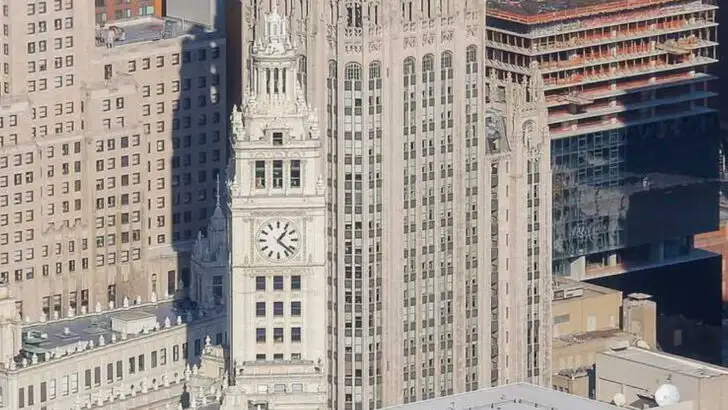Long before glass towers dominated city skylines, America’s first skyscrapers rose as daring symbols of progress. Built with steel frames and intricate designs, these early giants reshaped what a city could look like, blending engineering innovation with architectural artistry.
Today, many of these historic skyscrapers still stand tall, welcoming visitors to step inside, admire their detail, and experience the spaces that once defined modern ambition. They’re not just buildings — they’re living monuments to America’s urban story.
The Monadnock Building
Imagine a structure that marks the transition from load-bearing walls to steel-frame construction. The Monadnock Building in Chicago is this very marvel. Completed in two phases in 1891 and 1893, it showcases the evolution of architectural design.
Designed by Burnham & Root, it stands as the tallest load-bearing brick building ever constructed. Its north half is devoid of ornamentation, emphasizing pure form. The south half, however, hints at the future with its steel frame.
Visitors can marvel at its curved bay windows and rustic detailing, a testament to its dual-era conception.
The Rookery Building
Step into the Rookery Building, and you’re met with a blend of Moorish, Byzantine, and Romanesque styles. Designed by Burnham & Root in 1888, it was later remodeled by Frank Lloyd Wright, adding to its charm.
The building’s light court and exquisite staircase are architectural highlights. Wright’s touch brought in marble, gold, and elaborate ironwork, creating a lavish interior.
With its enduring elegance, the Rookery continues to house offices, inviting visitors to appreciate its historical and design significance.
The Wainwright Building
Standing in St. Louis, the Wainwright Building is an early example of the skyscraper as a “vertical city.” Completed in 1891 and designed by Louis Sullivan, it embodies the modernist ‘form follows function’ philosophy.
The building’s facade features intricate terracotta ornamentation, showcasing Sullivan’s belief in integrating art with architecture. Its steel frame construction marked a new era.
This landmark continues to inspire architects and visitors alike, with its innovative design still resonating today.
The Flatiron Building
In New York City, the Flatiron Building’s triangular silhouette is instantly recognizable. Completed in 1902, it was one of the city’s first skyscrapers and a marvel of its time.
Designed by Daniel Burnham, its unique shape was tailored to the site’s awkward plot. The building’s Beaux-Arts style is evident in its limestone and terra-cotta facade.
Though its interior remains private, the Flatiron’s exterior is a favorite photographic subject, capturing New York’s architectural innovation.
The Metropolitan Life Tower
As once the tallest building in the world, the Metropolitan Life Tower in New York stands as a symbol of ambition and progress. Completed in 1909, it features a design inspired by the Campanile in Venice.
The tower’s clock face and gilded details continue to capture the imagination of passersby. Its Classical Revival style highlights the grandeur typical of the era.
Today, it houses a hotel, allowing guests to experience its historic charm firsthand, set against the vibrant backdrop of Manhattan.
The Woolworth Building
Dubbed the ‘Cathedral of Commerce,’ the Woolworth Building in New York was completed in 1913. Designed by Cass Gilbert, its Gothic style set it apart from its contemporaries.
The building’s facade is adorned with intricate detailing, and its lobby is a spectacle of marble, mosaics, and stained glass. These elements earned it a designation as a National Historic Landmark.
Open for tours, the Woolworth Building invites visitors to experience a slice of architectural history from the ground up.
The Tribune Tower
Chicago’s Tribune Tower offers a glimpse into the city’s journalistic heritage. Completed in 1925, it was the result of an international design competition won by John Mead Howells and Raymond Hood.
The neo-Gothic tower includes fragments from world landmarks embedded in its walls, from the Parthenon to the Great Wall. This makes it a truly global monument.
Visitors are drawn to its intricate detailing and rich history, a perfect embodiment of Chicago’s architectural prowess.
Reliance Building, Chicago
Standing proudly in Chicago’s vibrant downtown, the Reliance Building is an architectural gem with a rich history. Completed in 1895, it exemplifies the Chicago School style with its steel-frame construction and elegant terracotta facade.
Designed by Burnham and Root, it was groundbreaking for its extensive use of glass and large windows. These features allowed natural light to flood the interiors, a novelty at the time.
Once a hub for medical professionals, it now houses a boutique hotel, offering visitors a chance to experience its historic charm and innovative design firsthand.

